
DECODING THE GIBSON FLATTOP: BODY SHAPES AND STYLES, TONE WOODS, AND “PERSONALITY”
Picking out a Gibson Acoustic guitar is a joyful, but sometimes daunting task. How does a player choose a model that resides inside his or her personal “Goldilocks zone”?
Choosing a Gibson was your first great move. Every Gibson acoustic guitar made today, is a direct descendant of the groundbreaking designs of the 30’s through the 60’s (even when it’s not a Vintage reissue). Gibson has over 125 years of experience, designing and producing Acoustic instruments that meet the needs of its players. It is nice to know your new Gibson shares the same DNA that made the classics, Classic. Each of today’s Gibson acoustic guitars stand on the same deep roots of innovation and craftsmanship that has defined the Gibson experience since the first days of the Steel string Flattop.

ELEMENTS THAT SHAPE THE SOUND OF YOUR GIBSON ACOUSTIC:
The most overlooked, decisive, and unique factor of any guitar is you, the player! As we decode all the features and variables available to choose from, take your personal playing style, and unique needs into consideration. Are you a finger style player? Flat picker? Singer/songwriter? Soloist? Accompanist? Band member? Do you have a light touch, or are you a hard-strumming string breaker, like Don Everly or Pete Townshend? Consider that today’s acoustic pickups provide a much more natural tone than in the early days of the J-160e. Today, body shapes and sizes have more to-do about pursuing tone, than pushing air.
There is no hard fast way to pick a Gibson acoustic. What is right for you does not have to coincide with the intended design use, or commonly associated styles. What sounds best to your ears? What fits best in your hands? What model has a look that makes your pulse race? You are the only one who can decide. Follow tradition or make new ones. Mix and match old-school tone with new-school electronics. With more tone wood choices, across the widest range of models, there has never been a better time to choose Gibson.
Gibson Acoustic Model types:
-
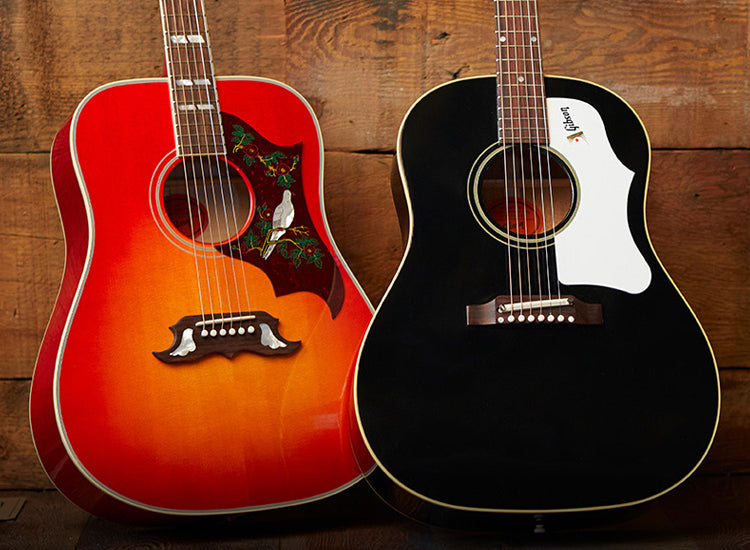
Original:
Flat Top models, made as they were in specific eras.
-
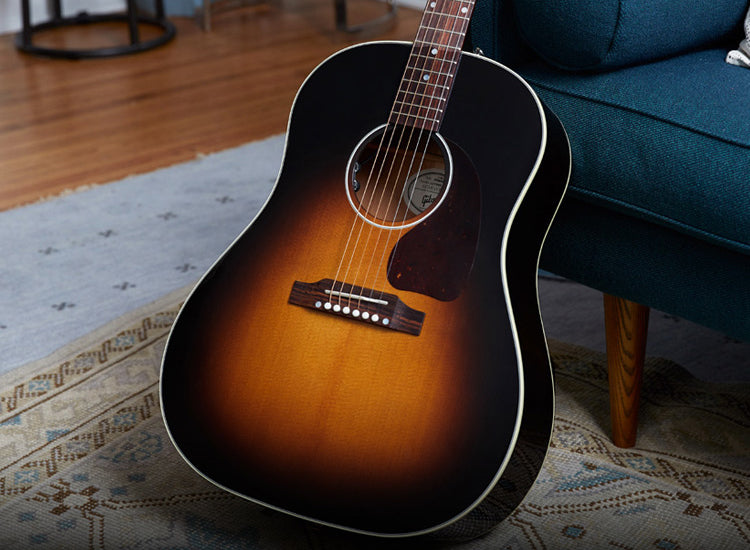
Modern:
Classic Gibson models, with new and traditional tone wood choices, and gently modified to better fit the needs of today’s modern player.
-
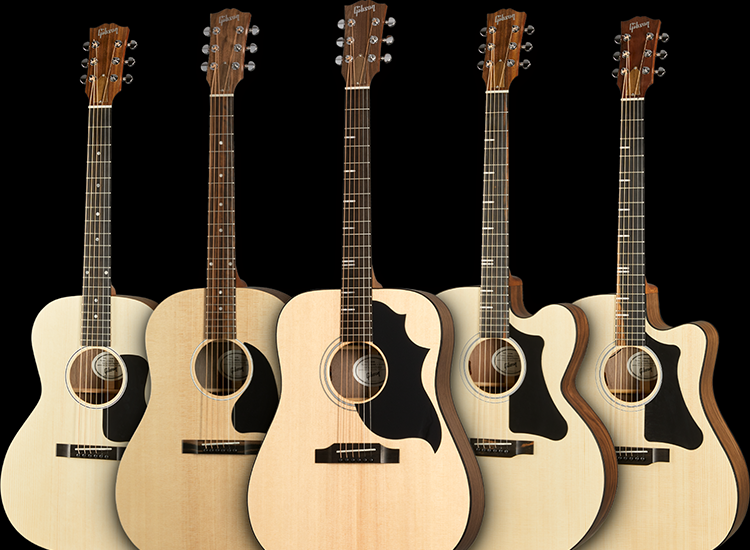
Generation
Gibson’s new “Generation” or “G series” models add a new dimension to the player's experience. An oval shaped sound hole on the upper side of the body called the “Player port” allows the performer to hear more of the sound projected towards the audience or recording mic. Not only is it an enjoyable experience but helps the player to fine tune the desired sound.
-
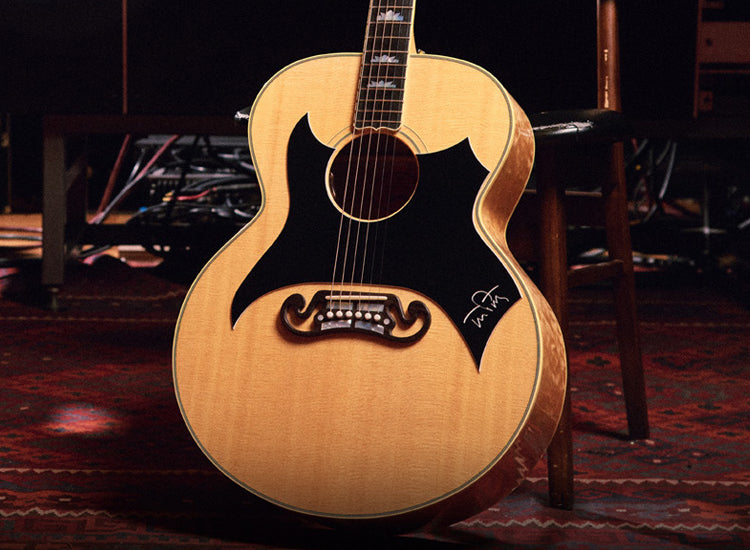
Artist:
Guitars made in the image of, or in tribute to one of Gibson’s world-famous players. Artist models can be Standard USA, Custom Shop, Epiphone, Kramer, limited production, or core product line.
-
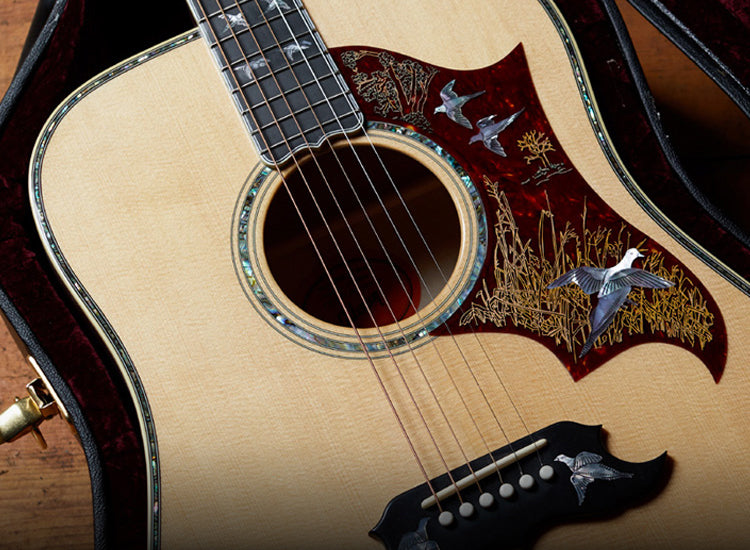
Custom Shop:
Gibson’s world-famous custom shop produces spec by spec recreations of Vintage classics, Artist signature models, Ornately appointed works of playable art, the Murphy lab created guitars with a gently aged look and broken in feel, through road beaten classics. The Custom Shop keeps things fresh, surprising and different. Expect great tone, playability, and most of all, the unexpected.
Body shapes and styles:

GIBSON SMALL BODY FLATTOPS (L AND LG BODY)
Gibson’s diminutive “L” body and slightly larger symmetrical “LG” body styles are the smallest full-sized Flattop in Gibson’s line. Despite the sweet and balanced tone, these diminutive, little gems were all but forgotten about until recent years. Gibson’s small body acoustic guitars have returned with a fury. Although the L and LG body size produces a fair amount of acoustic power, high quality modern pickup systems and other connectivity options completely level the playing field. It’s surprising the small body Gibson’s resurgence hasn’t come sooner, in a world that Volume no longer plays a role that’s more vital than tone and comfort. The L and LG body style are favorites for recording, performance, and practice. Capable of soft, sweet tones through punchy and focused without loss of balance and definition when pushed. A favorite of Blues pickers, fingerstyle players, or flat pickers. The full scale, small body L, and LG are comfortable in the arms of young and growing players, as well as full grown professionals. Favorites include, the 50’s LG-2, L-00 Rosewood, G-00 and more,
Available Types: Original, Modern, Artist, Generation and Custom Shop Collection.

ADVANCED JUMBO BODY
The Advanced Jumbo and Jumbo body styles are remarkably alike to the eye, but quite different in tone. The AJ has a longer scale length (25.5) and a slightly different waist contour. The result is a loud, full, and bold tone across all frequencies. The AJ can have a soft but rich tone, which can turn on a dime, and bring you into raw, wild booming powerful territory. Think of the AJ as the Incredible Hulk of Gibson acoustics: Mild mannered and balanced until pushed. Available from today’s Gibson Historic line as the 1936 Advanced Jumbo, 1939 J-55, 1936 J-35, and 1934 Jumbo
Available Types: Custom Shop

GIBSON JUMBO
The sloped or rounded shoulder Jumbo is Gibson’s most loved and defining body shape. Used as a foundation for the J-45, J-50, and Southern Jumbo. World renowned for its warm and balanced tone, the J-45 and company have been on the best sellers list since 1942. Great for all styles, in all eras. Favorites include Available from today’s Gibson on the 50’s J-45, 60’s J45, J-50, Southern Jumbo, J-45 standard, J-45/12, J-45 studio Walnut, J-45 studio Rosewood and more.
Available Types: Original, Modern, Artist, Generation, and Custom Shop

GIBSON ‘SUPER JUMBO'
Often called “The King of all Flattops.” You cannot miss the massive, and imposingly beautiful figure 8 shape of the Super Jumbo. The SJ body can move tons of air, but it takes effort to realize all she has to offer. The Super Jumbo is a great all-around guitar, with an emphasis on heavy rhythm playing. The SJ’s Hallmark tone is crisp, clear, bright, with a level response. The massive 17” top stays controllably balanced, even when strummed hard and heavy, with a big ole’ flat pick. Available from today’s Gibson as the J-200 standard, SJ-200 Studio Walnut, SJ-200 Studio Rosewood. The SJ-200 is an earful, and an armful. It takes a little extra effort to manage the size of the SJ, especially for players with a smaller stature.
Available Types: Original, Modern, Artist, Generation and Custom shop.

GIBSON JUMBO 185
The J-185/J180 shares the same silhouette of the Super Jumbo, in a smaller 16-inch size, that’s less of an armful than its daunting larger sibling. The tone is warm, with articulated power. Suitable for any style you can imagine. Today the J-185 body is available from Gibson as the J-185 original, J-185 EC (Electric Cutaway) Modern Walnut, J-185 EC Modern Rosewood, and more. Think of the Jumbo-185 as a more manageable alternative for players who find the behemoth “SJ” too big to hug. For players of all styles, the J-185 is a magnificent blend of size, shape, and tone.
Available Types: Original, and Modern.

SQUARE-SHOULDERED DREADNOUGHT JUMBO
Gibson’s square shoulder Dreadnought shape. Slightly larger than the Jumbo with a wider midsection. The Dreadnaught is not Gibson’s most traditional silhouette, but it has the Gibson sound. Big bottom, warm overtones, and power to spare. Well suited for open ringing chords, hard strumming, and finger style playing. Alive and well today in the Hummingbird, Dove, Sheryl Crow Country & Western, Songwriter EC Rosewood and more.
Available Types: Original, Modern, Artist and Custom shop

SONGWRITER/G-WRITER SQUARE SHOULDER DREADNOUGHT
The Songwriter is a marriage of Gibson’s 1930’s breakthrough X bracing, and a modern take on the square shoulder dreadnought. The ambitious new Songwriter series is an instant classic. The sound is clear, clean, bold, and sparkles across its entire range. Called Songwriter, but it is a performer at heart. Available today as the Gibson Songwriter Standard Rosewood, and Songwriter Standard EC Rosewood, and more.
-

Alto Music Holiday Gift Guide 2025
The Holidays Are Here — and So Are the Best Deals of the Year The holiday season can get hectic—but there’s no need to let the “holiday crunch” become overwhelming. At...
Alto Music Holiday Gift Guide 2025
The Holidays Are Here — and So Are the Best Deals of the Year The holiday season can get hectic—but there’s no need to let the “holiday crunch” become overwhelming. At...
-

Blast From the Past: 50 Years of "Wish You Were...
With industry success to back it up, many Pink Floyd fans consider "Dark Side of the Moon" the "greatest album" ever made. With the same breath, the fans (and the...
Blast From the Past: 50 Years of "Wish You Were...
With industry success to back it up, many Pink Floyd fans consider "Dark Side of the Moon" the "greatest album" ever made. With the same breath, the fans (and the...








